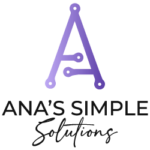As a neuro-spicy individual, I know how frustrating it can be to manage tasks and stay organized.
ADHD or not, organizing everything in today’s world is challenging and can sometimes feel like we are constantly chasing our tail. As I like to say “The juggle is real”.
The key to combating this chaos is actually quite simple, though difficult to achieve at times especially if you are being pulled many directions.
The fact is, no one can multi-task on multiple tasks at one time, especially when both of those tasks need concentration and focus. The only time it is possible is if you are doing something that requires low cognitive effort, like walking while listening to a podcast.
The only real way to work through tasks, is to do them, one by one. In order to do that you need a method to put them in a place where they can be easily referenced (a project management tool of sorts) and a way to find them easily that matches the context of the “project” they are part of.
In this post, I’ll be sharing some tips and tricks to help you become a better project and task manager. Whether you’re a busy entrepreneur, a working mom, student, or financial analyst moonlighting as an underwater-basket-weaver, these strategies can get you to stay on track and get things done. Getting things done is the key to opening your life up to all possibilities.

So, grab your favorite beverage (extra caffeine recommended) and let’s dive into the world of project and task management. You might just find that it’s not as boring as you thought, and that mastering online task management and project management can make you feel like a total ninja in your day-to-day.
Categorizing your tasks
Managing the “to-do’s” in life and business can be a daunting task in itself, and even more so if you struggle with ADHD or simply have too much on your plate. This is why I recommend categorizing your tasks into 3 groups to help contextualize each.
- Repeating operational tasks
- 1-time tasks that will take less than an hour to complete
- Project-based tasks that are either client-related or internal project related.
- Okay, this is a bonus one, but it’s also important to create emergency tasks, just in case there is something that needs emergency attention, like a downed website… or a pandemic or something.
Repeating Operational Tasks
These are those operational, repeating tasks that MUST be done to keep your business running. They can fall into any category of your business; marketing, operations, finances, etc. They are well-defined and have to happen at a regular cadence in order to function.
Like me and my coffee in the morning. Anyone relate????? 





These are daily, weekly, monthly, quarterly, even yearly tasks that need to be put on your agenda to make sure you dont’ disappoint a client or… get audited by the government. (YAY taxes)
Daily tasks might include routine activities such as checking emails or responding to messages, I prefer a “Daily activities’ task that has a checklist of everything I need to do every day, check emails, contact my clients, put out a social post, respond to questions.
Weekly tasks can include preparing for upcoming meetings or setting up appointments. I have “reviewing my finances” and “going through my newsletters” as one of my weekly tasks (usually done on Fridays when I have more “breathing” room)
Monthly tasks could include reviewing financial reports or analyzing progress towards long-term goals, while project-based categories could involve working on specific assignments or projects.

1-time tasks
You know those pesky tasks that need to be done, but don’t necessarily fit into a project or category? You know… like, you know you need to create a project plan for XYZ but you can’t put it under XYZ because it doesn’t exist yet
Or you need to remember to remove a client from their group program chat 2 weeks after the official end of their program, but it can’t be automated, but doesn’t really make sense to add it to the program workflow?
Yes, these tasks. They need to live someplace where they will get the attention they need.
I use the following rules to make sure I know what tasks belong in this category.
- The task must take an hour or less to complete (or it needs to be it’s own project)
- The task must not belong to an existing project or timeline
- The task is not an “idea” or something that belongs in a brain-dump area.
WARNING: Do not make this a dumping ground for all tasks that come into your head. The purpose of managing your tasks is so that you can more easily understand the context surrounding it and to make educated decisions on the correct priority of it.
Project-Based tasks
All previous project managers will innately understand this one.
These are all the tasks related to specific projects with an end goal (or a sprint goal) that you are currently working on.
These are usually Client projects, or internal business projects that have specific deliverables, timelines and people responsible.
Emergency Tasks
This is exactly what it sounds like. Tasks that need to be thrown to the top of the “important” pile. That should be highlighted in Red with exclamations after that require everyone to stop what they are doing and focus on the highest priority of all.
Use this one wisely, it should really be an “emergency” when used. Functionality of the business is impeded or someone unexpectedly is in the hospital and all of their tasks need to be delegated to someone else.
Effectively categorizing tasks is critical to getting the most out of your time and resources.
Putting them in the right places in your project management or task management tool is important for you and your team’s understanding of what is part of a project with a timeline, or what can be done in other parts of the day.

How to create project categories in your PM tool
 There are some of you that subscribe to the “nesting doll” theory of project management, where every task belongs to some sort of project. While that is a good theory, it is not as usable as one may think. Categorizing as stated above not only keeps tasks where they belong, but also allows for the “organized chaos” that business can bring, without blowing the whole organization system.
There are some of you that subscribe to the “nesting doll” theory of project management, where every task belongs to some sort of project. While that is a good theory, it is not as usable as one may think. Categorizing as stated above not only keeps tasks where they belong, but also allows for the “organized chaos” that business can bring, without blowing the whole organization system.Depending on the tool that you use, this can be done with folders, sub-categories or columns. Plain old to-do lists can be color coded to separate each of the tasks.
I challenge you to take a look at the tasks that you have for the next week, and categorize them using this FREE tool I created.
Defining the Scope of the Task/Project
Defining the scope and requirements might not sound like the most thrilling part of your project, but trust me, it’s important.
Keep in mind, this is for longer-term projects that have an ultimate final goal… repeating operational tasks will be talked about in a different section.
Especially when you are in the throws of doing all the things, and managing all the people… having an understanding from everyone involved in the project what the deliverables are, how long it will take and who will be working on it is pretty dang important.
I always create a project document, that outlines all the pieces of information that the project will be about, anything specific about that project that needs to be thought of, and who will be responsible for making it actually HAPPEN. (In many cases, that’s you!)
I recommend including the following:
- Name and Description of project
- Overall Goal of the project.
- When should the project be completed
- What are the deliverables from the project?
- What tech needs to be involved?
- What is the workflow of the final product?
- What are the potential issues with this project?
- Who will be working on this project?
- What are all the existing files/assets that are part of this project?
- Kickoff meeting.
Breaking down Projects into Tasks – Subtasks – Checklists
It’s easy to tell someone to make you a sandwich, but chances are, if you just do that, you are not going to get the sandwich you are hoping for. This is why breaking down projects and/or tasks into smaller sub-tasks is important.
When a task seems overwhelming or too large to tackle, breaking it down into smaller, more manageable pieces can make it feel less daunting.
To do this, start by identifying the key steps or components required to complete the task. You can do this on a document or word file, whatever you find easiest to use. Each step will have specific instructions for it and may need to be broken down even more.
Sometimes a task may have different parts, but doesn’t necessarily need to have “sub-tasks” added to them because they are something that everyone knows to do anyway. In this case, I recommend creating a checklist within the description of the task if possible, to still be able to support a new employee, or just help double-check for those more experienced.
Doing this will help the team stay more focused and organized. Your managers and CEO’s can track progress and identify roadblocks more easily and be able to hit deadlines first.
Also, breaking down tasks into smaller parts can also help with prioritization and using everyone’s time efficiently. Because the more you get done, the less you have to do!

Set clear deadlines and identify priorities
The job of the project manager is not only make sure that task are completed, but that they are completed by their deadline and are able to identify which tasks need higher priority in order to keep the entire project moving in the right direction.
These deadlines help communicate to the team how to manage their workload as well as assisting the managers in how to best support the team.
To do this, you simply need to add a “due date” to each of the tasks in the list. In many cases, the priorities will be the tasks that are due or almost due. In other cases, there may be a very hot job that comes across your plate, or something that needs to be done immediately in which case the Manager should communicate (or put a task in the “emergency” section of the Project Management tool) to make sure the initiative has the right support
Once you do this, it is imperative to encourage the team to meet the deadlines, and don’t fall into the trap of “Oops, deadline passed, oh well”.
You know what I’m talking about.
If this starts to happen, then there is a subtle message that goes out to the entire team that deadlines are optional, and they become less effective in the long run.
Once everyone is on board, and use to prioritizing due to deadlines I know you will notice how much more quickly things get done.
Increase that productive, not the stress level! D
Assigning tasks to team members
Okay, so we know what the task is, we’ve broken it down, we have given it a due date…. and now what?
Well we need SOMEONE to work on it!
Accountability people! It’s worth it’s weight in gold.
Every task, big or small should have an assignee.
This will ensure that everyone is crystal clear on their responsibilities and the workload is distributed evenly. That what we love… even Steven!
You should assign the tasks according to the “role” of the individual doing it. For example, I wouldn’t assign an account manager a task of posting social media (unless it was part of their role description), even if it’s part of a project they are assigned to.
All tasks in my opinion should be assigned by a project manager or whoever is in charge of creating the projects. Those “doing” the work should be focusing on doing, not thinking who should be in charge of the next step. I could write a whole other blog post about this… so I’ll stop there 

When you look at the task, think to yourself, “What role does this fall under?” and put the person in THAT role on that specific task.
Conclusion
So these are just a few tips to think about when organizing the tasks for your business, whether you are just 1 individual, or you are working with a team. The importance of categorizing, defining scope, assigning due dates, priorities and who is responsible is the framework of a project that is well communicated and effective.
Looking to learn more?
Check out these blogs:
Using ClickUp – Beginner Edition
Digital calendar organization system
Also sign up to get my Task Categorization tool to help start getting them organized.
Check out my YouTube channel where I walk through these concepts using ClickUp (my favorite project management too)
Want to chat?
Find me on Instagram and Facebook!



